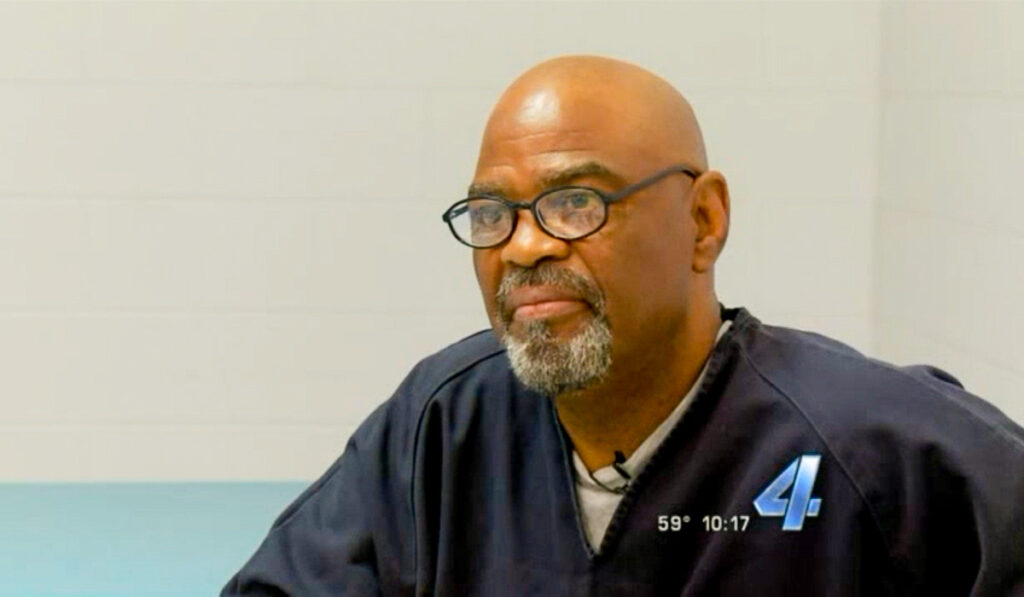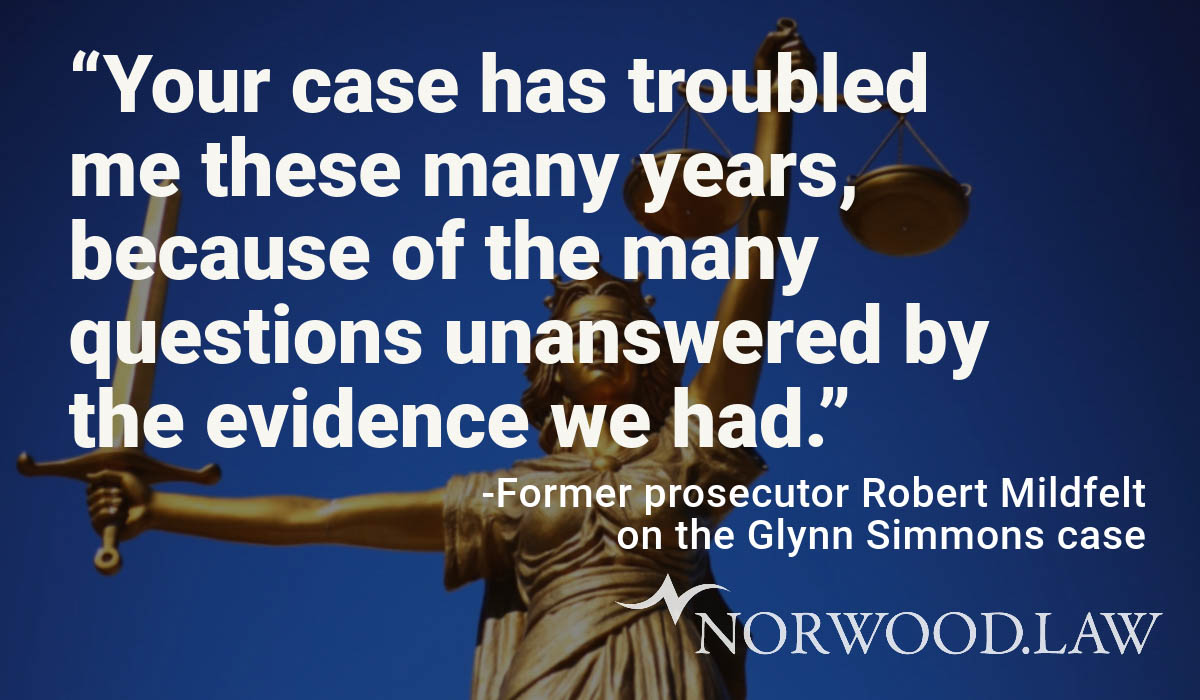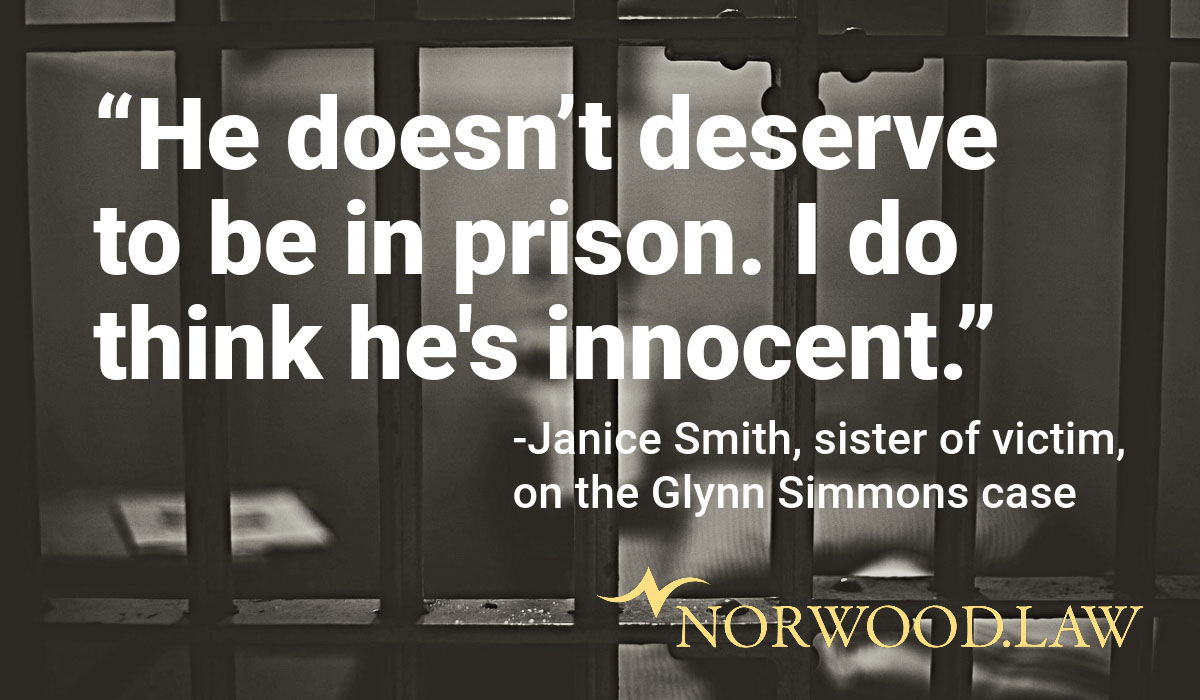Glynn Ray Simmons courtesy of KFOR-TV in Oklahoma City.
By G.W. Schulz
An Oklahoma City judge has declared that Norwood.Law client Glynn Ray Simmons will not face a new murder trial after he spent 48 years in prison. Citing a lack of evidence and other factors, prosecutors chose to abandon their case and ask that it be dismissed, which Oklahoma County District Judge Amy Palumbo has now approved.
As a result of the dismissal, the nonprofit National Registry of Exonerations led by the University of California Irvine says it will be entering Simmons into the organization’s database. That action would make him the longest-serving exonerated man in recorded U.S. history.
A person is eligible for the registry when there’s “a dismissal of all charges related to the crime for which the person was originally convicted.” Additionally, the dismissal must have occurred after new evidence of innocence became available that was not presented at the original trial.
In the case of Simmons, his conviction was first vacated in July of 2023, and he was released on bond pending a new trial. Now the case has been dismissed, so the trial won’t occur. One reason why is that a key police report seeming to point to his innocence was not made available to Simmons for his 1975 trial. The document was from the investigation of a 1974 liquor-store robbery in Edmond, Oklahoma, that landed Simmons and a co-defendant, Don Roberts, in prison for decades.
During the robbery, a clerk, Carolyn Sue Rogers, was murdered and a customer was shot in the head but survived. The missing police report raised crucial questions about whether the star witness in the case – the surviving customer – had identified Simmons and Roberts during a police lineup or two other men. Simmons and his co-defendant were ultimately convicted by an all-white jury following a trial that lasted just two days.
“I’m happy, and I’m free. It’s [been] a long, long struggle. I don’t know, man. I’m not usually at a loss for words. … We need to reimagine justice and how we do it,” Simmons told The Black Wall Street Times about his freedom. He added to The Oklahoman: “I was in prison for 48 years, 5 months and 13 days, and they let me out with nothing – I have absolutely nothing.”
Simmons and his co-defendant were initially sentenced to die after being convicted. They narrowly escaped execution when their sentences were amended to life in prison following a 1976 U.S. Supreme Court ruling. Simmons was 22 years old when he first went in and 70 when he came out, which means most of his life has been spent behind bars. Despite his ordeal, Simmons could still be denied compensation from the state of Oklahoma for his decades in confinement. That would mean only begrudgingly setting him free and leaving him with virtually no money, little means to support himself, and an ongoing battle with liver cancer. Supporters have created a GoFundMe account in an effort to raise money on his behalf.
Keep reading below to learn more about Simmons’s decades-long struggle for freedom and Norwood.Law’s efforts to find justice in his case.
Are you tied up in a legal conflict? Has the government accused you of a crime? If so, you’ll need the best advocates available to tell your side of the story. And it’s not just criminal law we practice. If you find yourself caught in a personal injury, business, or family dispute, Norwood.Law will bring the same commitment and skill to your corner that we did to the case of Glynn Simmons. When the time comes that you need us, contact Norwood.Law for a free consultation at 918-582-6464.
Burden at trial
The office of elected Oklahoma County District Attorney Vicki Behenna admitted in April of 2023 that Simmons was denied a fair trial when the police report describing what happened in a suspect lineup was not turned over to the defense. As a result, prosecutors said that “justice would be best served” if the conviction was vacated. Then the district attorney went a step further and conceded in late summer that, among other things, there wasn’t enough evidence to take Simmons back to court with a new jury.
It’s also possible prosecutors didn’t want to face a modern jury that might have dramatically different expectations about the evidence and testimony. Even one of the original prosecutors in the case has admitted that the proof against Simmons and Roberts was “thin.” Yet despite these developments, Simmons has still not been “exonerated” in the eyes of Oklahoma law for the purposes of compensation. Norwood.Law would have to make a special petition to the court to have him formally declared innocent, which we can now do. We’re also now able to make certain claims in federal court on Simmons’s behalf under the Fourteenth Amendment of the U.S. Constitution. It guarantees that people are not deprived of life, liberty, or property without a fair procedure.
Top prosecutor Vicki Behenna’s office cited several reasons for the requested dismissal in a media release. The surviving witness – around whom prosecutors built their entire case – is “not available” for a new trial, her office said. The involved detectives are deceased or unavailable. Also, prosecutors acknowledge Norwood.Law’s allegation that an alternate suspect is identifiable in the lineup report that was not given to Simmons for his 1975 trial. According to the media release:
“When considering whether to pursue the case against Simmons again, the district attorney determined the state will not be able to meet its burden at trial and prove beyond a reasonable doubt that Simmons was responsible for Ms. Rogers’s murder.”
Not to mention, Behenna’s office conceded earlier this year that the original prosecutors who first sent Simmons to prison had publicly expressed second thoughts. One of those original prosecutors acknowledged decades later that extensive research from psychologists and other experts had significantly altered how courts view the reliability of eyewitness testimony. In fact, misidentifications are a major cause of wrongful convictions in the United States.
The second prosecutor from the 1975 trial later went so far as to write letters on behalf of Simmons admitting that the case had “troubled” him for years. Robert Mildfelt wrote that it was one of the few cases he’d handled where the evidence was so thin, “the verdict a week later could easily have been different.” Additionally, Janice Smith, a sister of the clerk who was killed, has publicly expressed her belief that Simmons was not the perpetrator.
The co-defendant in the case, Don Roberts, was released on parole in 2008. But for decades, state and federal appeals judges and the Oklahoma Pardon and Parole Board inexplicably refused to extend the same consideration or mercy to Simmons.
Fell to pieces
To this day, Simmons insists that he has never even been to Edmond, Oklahoma, and hardly knew his alleged co-defendant, Don Roberts. Indeed, 14 alibi witnesses have given sworn testimony that Simmons at the time of the robbery was in Harvey, Louisiana, where he grew up. They describe him visiting with his son, celebrating the holidays with friends, and attending an amateur football game that was a local tradition. It was only later in 1975 after the new year that Simmons made a planned move to Oklahoma City for work. The investigation was still underway at that time, and Simmons became entangled in it.
But with so little holding the case together in the first place, it fell to pieces when prosecutors learned that the surviving customer who identified Simmons and Roberts would not be available to testify again for a new trial. There was never any physical or forensic evidence at all in the case. No fingerprints. No gun. No surveillance footage. The customer, Belinda Brown, admitted at the trial that she had only glanced at the two perpetrators for a few seconds before being shot in the head.
She also identified someone other than Simmons and co-defendant Don Roberts during a lineup that took place earlier in the investigation. Brown had picked a man out of 21 others and said he was at the liquor store. Investigators found otherwise after checking his alibi. But they refused to believe alibi witnesses for Roberts (who said he was in Dallas at the time) and Simmons. What records do exist make it unclear whether Brown actually identified Simmons and Roberts during lineups.
Questions about the reliability of eyewitnesses are pervasive in wrongful-conviction cases. In the public’s perception, law enforcers arrive to court with an abundance of forensic evidence and a long list of eyewitnesses who can recall people and events with perfect clarity. The truth is that far less can be used to send someone to prison or even death row.
In three separate cases handled by Norwood.Law, prosecutors presented no physical evidence whatsoever to gain convictions that involved decades in prison. In each case, they relied entirely on a single eyewitness and won lengthy sentences against Glynn Ray Simmons, Corey Dion Atchison, and Perry James Lott. Then after Norwood.Law took up these cases, years of work were required to get them in front of a judge for a meaningful review.
In the decades since these men were convicted, the use of eyewitness testimony has undergone a near revolution in America’s criminal justice system. To be sure, witnesses are still essential to fighting legitimate criminals. But psychologists and other experts have conducted countless research studies since Simmons, Atchison, and Lott were convicted to better understand the true accuracy of eyewitnesses. It turns out that human memory and perception are nowhere near as reliable as we once thought.
Memory degrades
As part of Norwood.Law’s efforts to understand the Simmons case, we recruited a PhD psychologist from Texas A&M University, Dr. Curt Carlson, to analyze what happened. In a detailed review, he called attention to numerous problems with Belinda Brown’s testimony and pointed to dozens of studies to support his conclusions. For example, human memory of an experience begins to degrade about three weeks after it occurred. That’s the point at which Belinda Brown saw her first suspect lineup. Brown had singled out a man who was not Simmons or Roberts as being “very close to the subject that shot her,” according to police reports. He turned out to have an alibi, however.
Brown then identified two new men two weeks later. The first man was “the one that I did not see that well,” according to police records. The second man – “I think” – was the one she exchanged hellos with as she entered the liquor store. At that point in the sequence of events, Brown was still unaware a robbery was taking place. In a second lineup, she identified the same two men again.
For reasons that are unclear, however, the names of the two men are blacked out in the police report. Simmons did not know about the document until a private investigator discovered it two decades after Simmons was sent to prison. Another document implies that Brown did, in fact, identify Simmons and Roberts. But the two men never had a chance to challenge the conflicting records in 1975. At trial, Belinda Brown would insist that it was Simmons and Roberts she had identified all along. Who precisely Brown identified is critical given that her identification formed the heart of the prosecution against Simmons and Roberts.
As noted, according to Brown’s own testimony, she only glimpsed at the perpetrators for just a few seconds. This would make it difficult for Brown to absorb memorable details about the suspects, according to Dr. Carlson’s report for Norwood.Law. She had just entered the store and did not know a clerk was already dead. Brown herself was seconds away from experiencing a traumatic brain injury by being shot in the head. Other research shows that two perpetrators instead of one can distract witnesses and impair the accuracy of identifications. Also, contrary to what jurors might believe, experiencing a high-stress event does not more deeply encode details about it into one’s memory.
Simultaneously, the recommended best practices for police lineups have undergone major modernizations since the time Simmons was convicted. The U.S. Justice Department convened a group of experts to write guidelines that are based on new understandings of human psychology and eyewitnesses. The guidelines are designed to help ensure witnesses are not accidentally or intentionally swayed by the biases and perceptions of investigators. Whether intentional or accidental, the presence of detectives can deeply influence whether a witness identifies someone from a suspect lineup. Among other things, the experts suggest these steps:
- Assure the witness the investigation will continue with or without an identification
- Instruct the witness to carefully describe how certain they are of an identification
- Inform the witness that the actual suspect may or may not be in the lineup
- Tell the witness that it’s just as important to clear the innocent as identify the guilty
Judges in Oklahoma are also armed with instructions for juries directing them to be mindful of the known weaknesses in human memory and eyewitness testimony. The Oklahoma Uniform Jury Instructions, as they’re known, instruct jurors to scrutinize eyewitness identifications with “extreme care.” They must seriously consider the possibility of human error or mistake and the fact that people may look alike. Did cross examination weaken the witness’s claim? Were there previous failed attempts to make an identification? Did the witness even have a good enough chance to see the suspect?
Unfortunately, many of the important revelations and reforms surrounding eyewitness reliability weren’t available decades ago when Simmons, Atchison, and Lott were convicted. For example, not until 2019 did Oklahoma require under a new law that lineups be conducted blindly without the participation of the detectives assigned to the case who might contaminate the procedure.
Witnesses also must now be told the suspect may not be in the lineup. What the law doesn’t do is automatically prompt review of past convictions that occurred when the criminal justice system was less enlightened. Appeals judges and parole boards do not become more inclined to reconsider convictions on the basis of new research or guidelines.
Fortunately, Simmons had Norwood.Law on his side. It just took 48 years to find justice.


